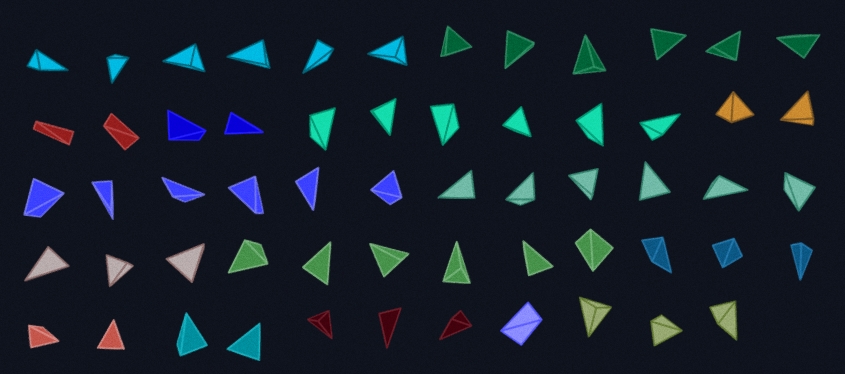
examples of space filling polyhedra |
The Fedorov's parallelohedra fill the space using only translations. Their faces are two by two opposite and parallel and each edge belongs to a set of parallel edges (four or six edges). There are only five, with their affine transformations: the cube (thus also all the parallelepipeds), the truncated octahedron, the rhombic dodecahedron, the elongated rhombic dodecahedron and the hexagonal prism (not necessarily regular or right).
If one of the above polyhedra can be decomposed into identical polyhedra, obviously the last are also space fillers: for example the cube can be decomposed into three or six square pyramids, into four bipyramids, into three pairs of symmetric tetrahedra ...
a regular right hexagonal prism can be decomposed into three regular triangular prisms ...
One can also fill the space using two distinct polyhedra, for example the regular octahedron and tetrahedron (see below), the regular dodecahedron and a curious non convex polyhedron.
|
| ||||||||
| The symmetric assembling of two tetrahedra on an octahedron builds a rhombohedron identical to those obtained by assembling two "clogs" along their squared faces; this parallelepiped obviously fills the space. | |||||||||
| Thus we get closely related space filling by using either rhombohedra or "clogs" or regular octahedra and tetrahedra. | |||||||||
| This first hendecahedron (11 faces) has two planes of symmetry.
Four of this polyhedron build an unit which fills the space according to a cubic type lattice. | |
| This second hendecahedron has only one plane of symmetry.
Six of these polyhedra build a "rosette". Two superposed "rosettes" of opposite directions build an unit which also fills the space according to an hexagonal lattice. | |
| These two curious polyhedra have the same topology and their common canonical form is self dual (with two planes of symmetry). |
It is well known that the stellated rhombic dodecahedron fills the space, but it is not obvious that the non convex rhombic dodecahedron above does the same. Its "center" belongs to six faces, two by two opposite and coplanar; this allows to say that its thirteen vertices define only nine faces, three of them being composed by two parallelograms with a common vertex.
|
|
This polyhedron with 10 vertices and 16 faces can be constructed by removing two tetrahedra along each of the four equatorial edges of an octahedron.
|
|
As Eduard explains one can construct this strange polyhedron from a regular octahedron: remove a tetrahedron along each edge, and then distort the faces (push the centers of four faces inside and likewise pull the four others outside); like this you get 14 vertices and 24 faces arranged in four "non flat hexagons".
|
|
|
|
|
Using computers Bjorn Poonen and Michael Rubinstein found 59 isolated rational tetrahedra plus two infinite families in the 1990s; It is only in 2020 that they prove, with Kiran S. Kedlaya and Alexander Kolpakov, that they are the only ones. Their classification required sophisticated methods and powerful computers to find special solutions of complicated equations.

At the start of 2021, a group of MIT undergraduates, together with Poonen, proved that one of the isolated rational tetrahedra does not fill space. This is the first example of a tetrahedron which is scissor-congruent to the cube but does not fill the space.
| references: | space filling polyhedra by Guy Inchbald and Eduard Bobik
Tetrahedron Solutions Finally Proved Decades After Computer Search Quantamagazine, 02/02/2021 Tetrahedron Undergraduates Hunt for Special Tetrahedra That Fit Together Quantamagazine, 09/02/2021 |
home page
 |
convex polyhedra - non convex polyhedra - interesting polyhedra - related subjects | October 2017 updated 01-03-2021 |